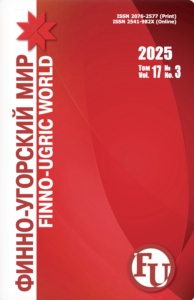DOI: 10.15507/2076-2577.012.2020.04.400-410
Lexical and semantic features of the names of herbaceous plants in dialects of the Khanty language
Fedosia M. Lelkhova,
Сandidate Sc. {Philology}, Leading Research Fellow,
Ob-Ugric Institute of Applied Research and Development
(Khanty-Mansiysk, Russia), lelhovafm@yandex.ru
Introduction. The vocabulary of the plant world of the Khanty language contains a significant amount of information, closely connected with ethno-mentality, ethnography and thinking of the people. In this regard, the study of vegetation seems to be one of the most interesting layers of the vocabulary, since it reflects the degree of practical and cultural development of the surrounding nature. The purpose of the article is to establish the lexical and semantic features of the nominations of wild-growing herbs, the definition of dialectal features. The aim of the research is to identify the nominations of herbs with the greatest possible completeness, to establish the lexical meaning of each name in dialects of the language. The relevance of the topic is determined by the research interest to the study of differences between the dialects in the theoretical and practical terms; the attention recently been paid to folk spiritual and material culture; and the loss of certain plant names in the modern Khanty language.
Materials and Methods. The study uses a set of methods and techniques for analyzing linguistic material: the method of semantic classification, lexical-semantic analysis, word-formation, linguistic-geographical analysis, as well as the elements of etymological analysis. The description is the main method for studying names of the plants. The source of the material is based on the vocabulary of the Khanty language, which was collected during field work; the source of Eastern dialects was the materials contained in lexicographic publications. When collecting the lexical material, the observation was conducted mainly on the speech of representatives of the older generation, as well as the people who have a traditional way of life, who retain the patterns of active spoken language. At the same time, not only facts that are in the active vocabulary of speakers were recorded, but also the words related to the passive vocabulary, which native speakers use only in conversations and sharing the memories of the past.
Results and Discussion. The study of dialectal material based on the names of plants in the Khanty language is of great research interest. The life of the Khanty people since ancient times is closely connected with nature, the vocabulary of the plant world covers almost all spheres of economic activity of the Khanty, thereby making up a significant part of their vocabulary. In Khanty linguistics, this vocabulary has not yet been the subject of a special and detailed study, which makes it an urgent research task for today. The article identifies the signs that underlie the motivation of plant names and highlights the borrowed words.
Conclusion. The collected vocabulary tells about the richness and vastness of phytonymic vocabulary of the Khanty language. The authors collected about 50 Khanty names of wild herbaceous plants in the Northern and Eastern dialects of the Khanty language. As a result of the research, new lexemes were identified and described, and the interpretation of the semantics of lexemes was clarified. Late borrowings of Russian origin are recorded. It was found that some dialect words are not actively used in the modern Khanty language. In flora vocabulary, the diversity and multiplicity of the nomination principles was revealed.
Key words: Khanty language; dialects; dialects; vocabulary; herbs; plant names; semantics; foreign language component; linguistics.
Acknowledgements: The author thanks the Pohjoishantin Šuryškarin kirjakielen kieliopin ja muiden apuneuvojen laatiminen project, and Koneen Säätiö foundation, with the help of which the expeditions to the northern Khanty were organized and lexical material on the topic was collected.
For citation: Lelkhova FM. Lexical and semantic features names of herbaceous plants in dialects of the khanty language. Finno-ugorskii mir = Finno-Ugric World. 2020; 12; 4: 400–410. (In Russian)






















